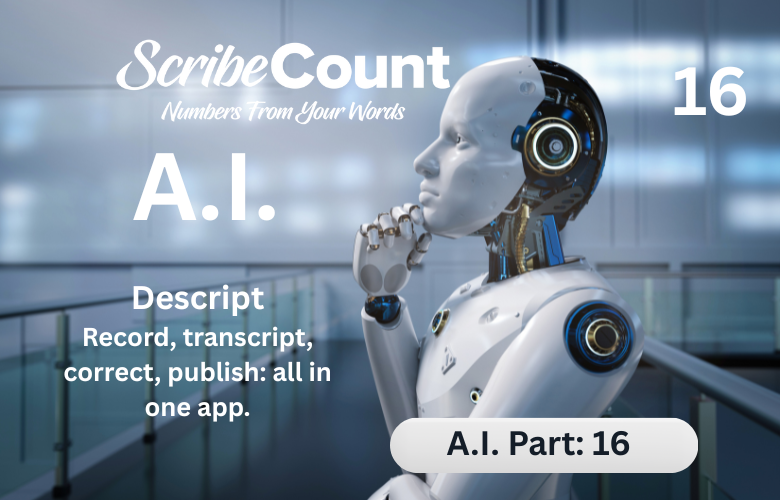Descript for Indie Authors: A Complete Overview
In the evolving landscape of self‑publishing, storytellers increasingly embrace multimedia formats—narrated podcast previews, audio‑enhanced drop scenes, or even full‑length audiobooks. Descript stands as a transformative platform blending automatic transcription, audio‑and‑video editing, text‑based content creation, and AI voice tools. For independent authors who write, record, produce, and promote their own work, Descript offers an integrated suite that unifies draft‑to‑audio workflows and opens new expressive frontiers.
This essay explores Descript’s journey from inception to present day, profiles its founding team, examines features through the lens of indie authors’ real‑world needs, surveys integrations with complementary tools, charts cost structures and learning curve considerations, balances strengths and trade‑offs, and closes with a positive review of why Descript belongs in the indie author’s toolkit.
Early Days: Research Roots to Creative Platform
Descript’s story begins in 2017, born from research in speech transcription and digital media editing. The founding engineers recognized that traditional audio and video workflows—cutting waveforms or editing timelines—were inaccessible for many creators. They envisioned a new paradigm: editing media by editing its transcript text. This leap—combining automatic transcription, natural‑language search, and “what‑you‑see‑is‑what‑you‑get” editing—sparked the first public releases of Descript in late 2018.
Initially pitched toward podcasters and video‑creators, Descript quickly found traction in writing circles. Authors realized that they could record live readings or draft audio sample chapters, transcribe them, correct mistakes via text editing, and export clean audio—all under one roof. Over time, Descript expanded into screen recording, overdubbing voice correction, filler word removal, and AI voice cloning. It has since become a go‑to creative suite not only for audio producers but also for authors eager to automate narration, clean interviews, or produce audiobook previews.
Today—mid‑2025—Descript is prized by indie authors for its ability to streamline dozens of production tasks: creating voice clips, assembling trailers, editing narration, generating transcripts for accessibility, and combining audio with visuals for promotional videos.
Founders and Design Ethos
The visionaries behind Descript combined expertise in audio‑analysis, machine learning, and user‑experience design. The founding team aimed to collapse traditional media production timelines by enabling creators to work in a familiar textual interface rather than mastering waveforms or time‑line editors. Their engineering roots in transcription services and early‑stage AI tools laid the foundation; their product philosophy centered on lowering technical barriers so anyone with a story to tell can produce audio‑and‑video content.
That ethos resonates deeply with indie authors, many of whom balance writing, editing, cover‑design, formatting, marketing, and (increasingly) audio production on small budgets. Descript’s founders sought to give authors a unified space where they can cut, polish, and repurpose content—transforming draft text into voice, then polishing that voice, exporting clean MP3 chapters, and even packaging audio for distribution through podcast channels or embed codes on author sites.
Core Features as Used by Indie Authors
Descript’s platform weaves together automatic transcription, a text‑based editor for audio and video, filler‑word removal, speaker labeling, overdubbing correction, AI voice parachutes, screen‑recording, and export bundles. Indie authors leverage these capabilities in creative ways.
An author might record a chapter reading on a phone, upload it to Descript, and rely on its transcription to spot mis‑read words. By editing the transcript directly, they clean up errors and remove ums or stutters. Descript regenerates the audio seamlessly. If a narrator mispronounces a character name, the author corrects it in text and uses Overdub—a voice‑cloning feature—to patch in a clean version. This removes the need to re‑record full segments.
Authors use Descript to produce audiobook trailers: combining voice snippets with visuals or B‑roll in Descript’s video timeline. They generate promotional shorts for social media, syncing clean audio to on‑screen text overlays. Writers experimenting with scene drops or serialized fiction publish narrated excerpts weekly—exporting directly from Descript to podcast feeds or embed players.
For accessibility, authors publish transcribed audio content as blog posts—ensuring readers preferring text or who rely on screen‑readers have access. Descript’s speaker‑separation helps authors podcast multi‑voice dialogues or recorded interviews about their book.
Descript also supports script‑based editing, so authors drafting narrated scripts or Q&A chapters can refine voice‑over content alongside draft manuscript text—bridging writing and audio workflows in one collaborative project.
Integrations in the Author Ecosystem
Descript connects to complementary platforms through export formats and APIs. Finished audio files (MP3 or WAV) flow into ACX or Findaway Voices for distribution as audiobooks. Visual exports find homes on YouTube, IG Reels, TikTok, or author landing pages. Transcripts feed into WordPress or static‑site generators as accessible blog content.
Authors often combine Descript with AI writing tools—Drafting in ChatGPT or Sudowrite, exporting text, using Descript for narration. Audio cleaned and mastered in Descript is then enhanced in tools like Audition or Descript’s built‑in mastering tools.
Community workflows link Descript with Zapier or Make: e.g., once a chapter is exported from Descript, it triggers an automated upload to podcast platforms or backup to cloud storage. Other creators pair Descript’s screen recording with Canva to produce book teasers or create video walkthroughs of their writing process.
Cost Structure and Learning Curve
Descript offers several pricing tiers: a free plan with limited transcription minutes, Standard and Pro subscriptions unlocking higher minutes, filler‑word removal, video export, Overdub voice‑cloning, and collaboration features. Authors generating short content or teasers easily work within free‑or‑mid‑tier limits; audiobook‑length projects typically require Standard or Pro plans. Enterprise or team plans support co‑author collaborations, project folders, and advanced export options.
Learners find Descript intuitive: the text‑editor metaphor maps directly to published manuscript editing habits. Authors new to audio spend a day recording and cleaning a chapter to become fluent. Deeper features—voice‑cloning, filler‑word fine‑tuning, multi‑speaker editing—require more time to master, but Descript’s help center and community tutorials guide users smoothly.
Because it co‑hosts audio and text—without needing separate DAWs—authors often report initial workflow acceleration within hours of first use. However, larger audiobook projects may push plan quotas or demand attention to export formats and chapter segmentation.
Strengths and Limitations
Descript delivers a unified platform where indie authors can move from recording to transcript to polished audio without switching tools. Its Overdub ability lets authors patch mistakes quickly without full re‑recordings. The text‑based editing approach harmonizes with writing workflows, minimizing friction for non‑technical creators. Built‑in screen‑recording tools support narrated video content—raising promotional opportunities.
On the flip side, Descript’s voice‑cloning requires high‑quality initial recordings for best results, and Overdub voices, while expressive, may lack deep emotional nuance compared to human narrators. Major audiobook projects may trigger plan upgrades for minute quotas or export limits. Some authors find advanced video timelines overwhelming compared to pen‑and‑paper drafting tools. While the platform trims audio imperfections, deeply poetic or heavily dramatic narration may still call for human voice talent or external audio refinement post‑Descript.

